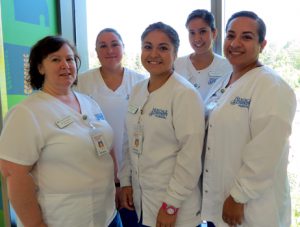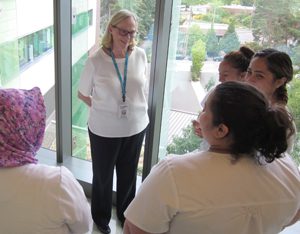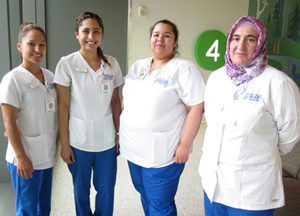
A lot can happen in a month. A patient can beat their illness.
A crawling baby can take their first steps. And a nursing student can learn skills that will save lives.
The latter is certainly happening with students from Heritage University, who have visited Seattle Children’s in two waves this summer.
The university, which is located on the Yakama Indian Reservation in Toppenish, Washington, partnered with Seattle Children’s for the first time.
“It’s different here than anyplace else we’ve been,” said Claudia Padilla, one of four students who came for training in June. “The support from nurses was amazing; I felt trusted to take full care of patients and encouraged to try new things.”
Caring for vulnerable children
Padilla and her peers went through an intensive rotation, spending four days a week at the hospital for four weeks. Not only are they the first Heritage University students to train at Seattle Children’s, theirs is the inaugural cohort of the university’s new Bachelor of Science in Nursing (BSN) degree program.
“At Seattle Children’s, our students have been able to internalize the professionalism, clinical judgment and safe care of children learned in their BSN coursework,” said Christina Nyirati, chair of the Heritage University Department of Nursing. “With the fine clinical training they are receiving, our graduates will contribute to safe and effective nursing care of children in the lower Yakima Valley, who are some of the most vulnerable children in Washington.”

The nurses are fully immersed in the learning environment at Seattle Children’s, according to Leslie Harder, director of Nursing Professional Development.
“They get to truly understand the continuity of nursing care by working with the same patient and the same nurse day after day, quickly building their knowledge and skills,” said Harder.
Harder adds that the Heritage students are a pleasure to work with.
“They are profoundly respectful, hungry for information and totally focused and engaged when they’re here,” she says. “The students recognize the importance of this opportunity to gain pediatric care experience, and they want to get the most out of it.”
Highly diverse group brings unique perspectives
But the students aren’t the only ones who gain from the experience.
This highly diverse group of future nurses brings unique perspectives to Seattle Children’s. Along the way, the nursing team hopes to discover ways to better support diverse students — as well as diverse patients.

Harder also sees it as an opportunity to broaden diversity in the nursing profession.
“More than 80% of nurses nationally are Caucasian, but our patients are not 80% Caucasian,” said Harder.
Through several avenues — like partnering with schools, leading nurse camps and recruiting people from different backgrounds — Seattle Children’s strives to strike a better balance.
The benefit extends beyond Seattle Children’s too, since many of the Heritage University students plan to return to Central Washington and serve patients in the communities where they live.
“We get people into this profession by opening our doors to diverse nurses, and helping them scholastically and through mentorship,” said Harder. “This is the right thing to do.”
A number of people came together to make the partnership possible, including an anonymous donor who paid for the students’ housing at the University of Washington.
“We are extremely grateful,” said Padilla, “because this experience wouldn’t be possible without support from many people at Seattle Children’s — including the person who provided our housing.”
Padilla says she has learned a lot during her time at Seattle Children’s, and she’s clear about how she’ll use her knowledge.
“One of the main things I like about the care here is that it’s holistic and family-centered,” said Padilla. “I’m amazed to see how the nurses care for the families; I definitely want to carry that forward and make families part of the care I provide as a nurse in the future.”
Resources
- Nursing at Seattle Children’s
- Nurse Camp Ignites Passion for Saving Lives

